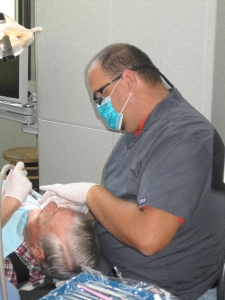
(913) 631-2400



Dr. Dallan E. Greenhalgh

5636 Nieman Road Shawnee, KS 66203



Office Hours
Monday
Tuesday
Wednesday
Thursday
8 am - 6 pm
7 am - 2 pm
11 am - 6 pm
8 am - 5 pm


GREENHALGH FAMILY DENTAL HAS MOVED!
New Address: 5636 Nieman Road Shawnee, KS 66203



Is there an easy way of repairing my chipped tooth?
We've provided answers to a number of commonly asked dental questions. If you have a question that is not addressed here please e-mail Dr. Greenhalgh directly at doctors@greenhalghdental.com or call us at (913) 631-2400. We look forward to resolving all of your dental concerns:
A: While bad breath might be a symptom of some other disorder, it most likely stems from dental decay and periodontitis. Periodontitis is a disease affecting gums and bone that support the teeth, and it results from inadequate tooth brushing and flossing. In this disease, the irritated gums pull away from the teeth and form pockets between the teeth and the gums. These pockets fill with bacteria which give off a foul odor.
Patients with bad breath need a complete dental evaluation. If gum disease and/or dental decay are diagnosed, it can be treated readily. The patient will no longer have an infection in his or her mouth, and he or she will no longer have the embarrassment of bad breath.
Q: Is there an easy way of repairing my chipped tooth?
A: Cosmetic bonding is an importable, quick and painless way to repair many cosmetic flaws or injuries, including:
Dental bonding sculpts individual teeth without requiring removal of any tooth structure. This technique bonds a composite material that looks, acts and feels like the real thing, to an existing tooth. This procedure usually doesn't require the use of an anaesthetic; is relatively quick to apply; gives an immediate result and is less expensive than veneers.
A: Bleaching is a safe, effective and relatively easy means of producing a whiter smile. We offer several options for whitening your teeth.
- Tres White (pre-filled disposable trays) - features pre-loaded whitening trays that fit comfortably over your teeth. The tray is discrete and disposable making it easy to whiten on the go. It’s an affordable option for just 30-60 minutes per day. You’ll get noticeable results in about a week.
- Take Home Trays- Customized upper and lower bleach trays will be fabricated after impressions of your teeth are take. The whitening gel is then placed into the tray and work for an hour each day for 1-2 weeks, or until you get your desired result
- In Office Whitening (Boost) - For a brighter and whiter smile without the wait we off an in-office chemically activated whitening treatment that offers results in about an hour. No heat involved. It also contains potassium nitrate and fluoride which help to improve oral health by strengthening enamel ad decreasing sensitivity and offering cavity protection.
Even with today's advanced whitening techniques, not everyone's teeth will whiten with the same results. During the visit with your dentist, your situation will be evaluated carefully and you will be advised accordingly.
Q: What are porcelain veneers?
A: Porcelain veneers are often used for the same reasons as bonding; to lighten stains, close gaps and even alter crooked or malformed teeth. You can change the shape, color and length of your teeth using veneers. They are thin, durable shells designed to cover the front of the tooth. They are typically made of porcelain and are extremely durable, stain resistant, natural-looking and easy to maintain.
Veneers are custom-fitted to your teeth by removing a small amount of enamel and bonding the veneer to your teeth using a safe, high tech polymer resin. You can expect veneers to stay bright and strong for many years by performing good oral hygiene.
Q: Why do I need a crown instead of a bigger filling?
A: Teeth are often restored using silver or composite tooth colored fillings. However, when too much of a tooth’s structure is removed to support a filling, a crown or “cap” may be needed. A crown may be needed to:
A crown essentially covers a tooth to restore it to its natural shape and size. This permanent covering fits over your original tooth to strengthen or improve the appearance of the tooth. Fitting a crown generally requires at least two visits to the dentist’s office.


WEBDEBSITES

- Gaps in Teeth
- Spots or stains
- Chipped Teeth
- Restore a tooth when it is unable to support a large filling
- Protect a weak tooth from fracturing or restore fractured teeth
- Attach Bridges
- Cover badly shaped or discolored teeth
- Cover dental implants
Q: Do I need to replace my silver amalgam fillings?
A: Studies have shown that there is no medical risk associated with silver amalgam dental fillings. As long as the filling is in good condition and you are not having any pain or sensitivity associated with the teeth that have silver fillings in them, there is no need to immediately replace them.
When your silver fillings begin to break down and need to be replaced we will often replace them with the newer composite (white/tooth colored) materials but they can be replaced with new silver amalgams if so desired. Recent innovations now allow us to replace composite or porcelain fillings that are as strong as the silver amalgam fillings and more natural looking.
Silver amalgam fillings require more tooth structure to be removed and the retention for the filling is actually due to the shape of the preparation the dentist makes in the tooth; where as the white composite fillings actually bond to the tooth structure requiring the dentist to remove less of your tooth structure for the preparation of a new filling. For this reason white composite fillings are often now the first choice when restoring a tooth that has never had a filling before.
Q: What do I do if my tooth is loose or knocked out?
A: Know the proper first aid for saving a loose or dislocated tooth. If the tooth is loose, even extremely so, but is still attached in any way, leave it in place; do not remove it. If it is out of its socket completely and unattached, but still in the victim’s mouth, it is best to have the person hold it there, if possible, until a dentist can attempt re-implantation. If it is out of the mouth, do not let it dry out. Handle it as little as possible.
Do not attempt to disinfect the tooth, or scrub it, or remove any tissue attached to it. If it is recovered from the ground or other soiled area, rinse it off in lukewarm water. Preserve it in milk until a dentist is available. If milk is not available, lukewarm water will suffice.
Time out of the socket is critical in the long-term success of re-implantation. After 30 minutes, the success potential begins to decline. However, re-implantation is still possible after several hours, so the attempt can still be made even if the tooth has been out for a long period.
A: More seniors today have retained their own teeth, avoiding the trauma of the removable dentures. Many are on medications creating dryness of the mouth as a side affect. Without the natural benefit of saliva to decrease bacterial action, we see an increase of cavities on the root surfaces of these patients. Anyone on a medication causing a dry mouth effect should be encouraged to see their dentists for regular dental cleanings and topical fluoride rinses.
There are also some over the counter products (not requiring a prescription) that are made to help dry mouth, and some patients have found these to be useful. Ask the doctor or the hygienists for more detailed information on these products.
Q: What is periodontal disease?
A: Gum disease, or more correctly called “periodontal disease”, is a bacterial infection in the gums and supporting structures of the teeth. It can be divided into several categories. The first stage is called “gingivitis” and is characterized by gingival (gum) tissue that is red, puffy, and bleeds easily when touched with a tooth brush, floss or dental instrument.
The second, third, and fourth stages are initial, moderate, and advanced “periodontal disease”, respectively. These stages are different from gingivitis because the infection has destroyed the bone supporting the teeth, causing eventual tooth loss. The treatment is more involved at these stages, usually consisting of a special cleaning with anesthesia and sometimes gum surgery. Periodontal disease can go on for years without pain and without detection unless specific examination procedures are performed. Visual oral examination by itself (even by a dentist) will not reliably detect periodontal disease until it has reached an advanced stage.
Early detection and adequate diagnosis require measurement of pockets (the crevice between the tooth and gum) with a periodontal probe, and radiographs (x-rays) of the bone supporting the teeth are needed to determine the full extent of the disease and damage it has caused. Effective prevention and treatment is available, but the damage caused as the disease progresses is irreversible. Early detection and treatment is critical to prevent tooth loss and disfigurement.
Q: What should I do if I lose a tooth?
A: Losing a tooth by accident or by extraction is not the end of the matter. When a tooth is missing, the resulting gap will allow nearby teeth to tilt or drift from their normal position and the teeth above or below the gap will move downward or upwards respectively. Aside from the obvious cosmetic problem, this change in position of these teeth can lead to severe bite problems causing jaw pain and headaches.
Missing teeth should be replaced to keep other teeth in their normal position. This can be done by means of a fixed bridge, a dental implant or a removable partial (usually done to replace several teeth missing in the upper or lower arch). All of these treatments offer good functional and cosmetic results, however the fixed bridge and dental implant will offer better cosmetic results.
A: A fixed bridge usually is made to replace a single tooth or possibly two missing adjacent teeth. The teeth on each side of the space will be prepped for a crown (“cap”) and an impression will be taken. A lab will fabricate the bridge for the dentist; that is they will fabricate the two crowns (for the teeth on either side of the space) and will place a false tooth between the two crowns to cover the space where the teeth are missing. The bridge will be an all porcelain or metal with porcelain covering (esthetically pleasing and natural looking) that will be permanently cemented into place restoring those teeth that were missing improving the function and the esthetics of your overall smile.
A: The loss of just a single tooth can lead to problems with adjacent teeth and even the teeth that would normally bite against the missing tooth. Teeth will drift and tip into a space that is created by the missing tooth or teeth. When you lose a tooth, a dental implant may be used or needed to replace the tooth root and crown. Dental implants are simply “anchors” that permanently support replacement teeth. They are secure and durable and can be cleaned and cared for much like your natural teeth.
The procedure requires a titanium root form be fitted into your jaw bone to replace the lost tooth’s root(s). Once the implant is anchored into the bone, the bone around the implant requires between six weeks and six months depending on location for healing. Once the bone has healed, a support post and replacement tooth (a crown) is anchored into the implant.
